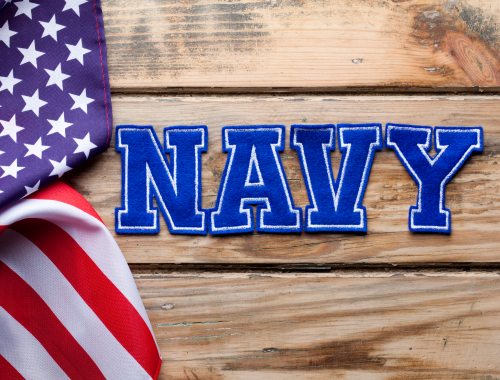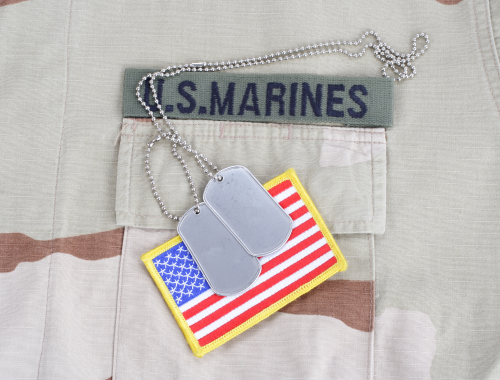The U.S. Navy is the major military branch of the U.S. armed forces in charge of protecting the country at sea. The Marine Corps, also called the Marines, is an independent branch of the Navy that serves under the command of the U.S. Navy, ever since Congress put the Navy in charge of the Marines in 1834. Together, Marines and Navy provide a powerful, combat-ready combined arms force, capable of both maritime and land-based operations to defend national interests and respond to global threats. In this article, we look at the two military branches and shed light on some key similarities between the Navy and Marines.

U.S. Navy
The U.S. Navy is the military arm of the Department of Navy responsible for maritime operations, including naval warfare, operating and maintaining ships, submarines, and aircraft carriers. When the country is at war, the navy fights enemy ships and fires at strategic points on enemy land from the sea. The main purpose of the Navy is to maintain and protect the U.S. interests at sea.

U.S. Marines
The U.S. Marine Corps, also called the Marines, is a branch of the military and a component of the Navy that focuses on amphibious combat and operations, protecting naval bases and guarding U.S. embassies, as well as providing a combat-ready strike force charged with protecting the interests of the nation. The Marines and Navy often work together for joint operations.
Key Similarities between Navy and Marines
The Department of Defense
– The Marines is an independent branch of the U.S. Navy and the Navy is a major defense arm of the U.S. armed forces. Both Navy and Marines are branches of the U.S. armed forces under the Department of Defense (DOD). They have distinct roles but share common goals. The Navy focuses on naval operations, while the Marines are a specialized component of the U.S. Navy providing ground combat forces. They share a close relationship which aids in joint operations both on land and at sea.
Unified Mission and Strategy
– The Marine Corps has been a part of the U.S. Navy since 1834. Both Navy and Marines share a unified mission to protect the interests of the country and maintain security worldwide. Both fulfill a critical military role which allows them to work in tandem during critical operations, wherein the Navy transports and supports Marines for coastal assaults. They share a commitment to national defense and respond to various contingencies, whether in conflict or humanitarian missions.
Eligibility and Training
– The recruits of both the Navy and Marines go through rigorous training and physical tests to maintain a high level of readiness and be combat-ready. The applicants of both branches must be between 17 and 28 years old, have a high school diploma or equivalent, and pass a criminal background check. They will also have to pass the Armed Services Vocational Aptitude Battery (ASVAB) test. The training can last for about 12 weeks and focus on areas such as physical fitness, discipline, and basic combat skills.
Core Values
– Another key similarity lies in their shared core values, which define how each soldier thinks, fights, and acts. The core values are honor, courage, and commitment, and are deeply ingrained in the ethos of both defense branches. Upholding these principles ensures unity, professionalism, and ethical conduct across the Navy and Marines. This reflects their commitment to serving the nation and upholding the ideals that define the U.S. military’s reputation worldwide.
Summary
Both are two of the most decorated branches of the U.S. military that serve under the Department of Navy and share a similar training regimen. Although both have distinct roles and missions, they share the same core values of honor, courage, and commitment. Both branches require their recruits to pass the ASVAB test and have the necessary training program which can last for about 12 weeks. Talking about their missions, the Navy is all for naval warfare, while the Marines focus on amphibious warfare. However, both branches often work together in joint operations.
FAQs
Are Marines higher than the Navy?
No, the Marines is a component of the Department of Navy and both come under the United States Department of Defense. Both are separate branches of the U.S. military and are on equal footing under the Department of the Navy. However, each branch has its own unique roles, responsibilities, and areas of expertise.
Are the Marines and Navy connected?
Yes, they are indeed connected. The Marine Corps is a component of the Navy operating under the Department of Navy. They share common administrative and logistical support and often work closely together in joint operations and humanitarian missions.
Is Marines harder than the Navy?
Yes, the Marines training programs are more physically demanding and challenging than Navy basic training. The Marines have to go through more rigorous combat training and physically demanding missions, whereas the Navy encompasses a wide range of specialties, including shipboard operations, aviation, and submarine service.
What is the hardest branch of the military?
In terms of educational requirements, it’s the U.S. Air Force. The military branch, however, with the toughest combat training and exercise is the Marines. The special operations units within each branch, such as Navy SEALs, Army Rangers, and Air Force Para rescue, undergo some of the most challenging and intense training across the entire military.
What is the weakest branch of the military?
The term weakest may not be appropriate in this context as each branch of the military plays crucial roles in national defense and possess unique strengths and capabilities. However, the branches with less intense training and requirements are probably the Coast Guard and the National Guard.
What branch is the first to fight?
The Marine Corps is often the first on the ground to engage in combat and secure strategic positions, especially in amphibious operations and initial landings during conflicts.
Difference between the Navy and marines
The Navy is responsible for naval warfare, while the Marines are responsible for amphibious warfare. The Navy is responsible for maritime operations, including naval warfare, operating and maintaining ships, submarines, and aircraft carriers. The Marines, however, are a specialized ground-combat force with a focus on amphibious assaults.













Leave a Reply